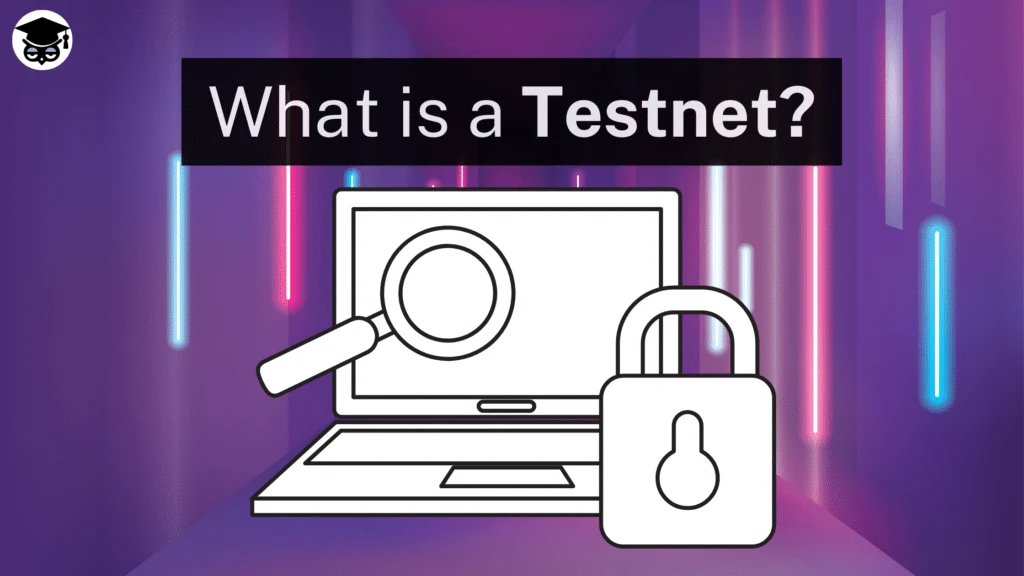What is a Testnet?
A testnet is a separate blockchain where developers can test changes and upgrades to the protocol risk-free.
The Long Definition
A testnet is an almost identical copy of a blockchain that is separate from the main network (mainnet). It is typically used by developers to test upgrades and changes to the protocol. It can also be used by regular users to experiment with cryptocurrencies on the blockchain.
Since the testnet is usually separate from the mainnet, all this is done without having to worry about adverse consequences.

Understanding Testnet
Blockchain protocols like Bitcoin, Ethereum, Polygon, etc., are written in code. This means that a blockchain is a program at its core. And like any program, developers regularly implement upgrades, new features, and bug fixes.
But a blockchain is not like your regular application. It is a platform for sending, receiving, and storing crypto coins and tokens. In addition to that, there are networks, like Ethereum, that support an entire financial ecosystem.
This ecosystem is known as decentralized finance (DeFi). It consists of exchanges, lending platforms, and NFT marketplaces. It has millions of users and is collectively worth billions of dollars.
Incurred Risk
There is a lot at stake when it comes to updating and maintaining a blockchain protocol. If an update containing an error goes live, it could bring the network down. This will affect millions of users. An error can also create vulnerabilities that hackers will exploit to steal from users.
But a blockchain, like any other program, still needs regular updates to work properly. So, how do developers deal with the massive risk?
This is where the protocol’s testnet comes in. This is a separate network that is more or less similar to its parent protocol, called the mainnet. It has its own set of nodes that maintain it.
However, unlike the mainnet, nothing crucial runs on it. There are no valuable cryptocurrencies or millions of users relying on the network.
This provides a risk-free environment. Therefore, developers can test out new features, upgrades, and fixes on the protocol. Any errors that they encounter there will not affect the security and stability of the main network. This allows them to keep experimenting until they find the correct implementation.
Once a new feature or fix has been proven to work on the testnet, it can then be posted on the mainnet and go live on the blockchain.

Do Testnet Blockchains Have Cryptocurrencies?
Yes. A testnet will have its own cryptocurrency. However, the coins have no real-world value. They are there to allow developers and users to experiment with features that are about to be posted to the mainnet. Thanks to these coins, users can learn the ins and outs of the blockchain without the risk of losing real money.
Testnet Examples
The crypto ecosystem has many testnet blockchains. The most popular of these are Ropsten, Kovan, and Rinkeby for Ethereum. These are used for testing and experimenting with Ethereum-based technologies like decentralized applications (dApps) and smart contracts before they’re deployed on the mainnet.
There is also Testnet-3. This is the official Bitcoin testnet that is used for experimenting with new Bitcoin upgrades, features, and technologies. It is designed to be as similar as possible to the main Bitcoin blockchains. Other Bitcoin testnets include Regtest, Signet, and BitcoinJS Testnet.
Polygon also has its own testnets. These include Mumbai Testnet, which is the protocol’s official testnet. It is designed to provide developers with a safe, risk-free environment to test and deploy their dApps and smart contracts. Kovan and Rinkeby can also be used because they are compatible with Polygon.

How To Use a Testnet
Testnets are a valuable tool for learning how blockchain technology works. They give you hands-on experience in a risk-free environment. Therefore, you don’t have to worry about losing money as you learn.
To use a testnet, you must first add it to your crypto wallet. The process of doing so doesn’t differ much between blockchains. Therefore, we will use Ethereum testnets as an example.
To use an Ethereum testnet;
- Research available options: Ethereum has several testnets. These include Kovan, Ropsten, and Rinkeby. Before settling on one, it’s always best if you research it to see whether it suits your needs.
- Install an Ethereum wallet: You’ll need to install an Ethereum wallet if you don’t have one already. Metamask is a good option as it allows you to add and switch between testnets easily.
- Connect your wallet: Connect your wallet by entering the required configuration. Different testnets have different configurations. These will be provided to you.
- Obtain coins: You can obtain testnet ETH coins from a faucet. This is a service that provides free coins for different testnets. Each testnet has its own faucet that will send you free coins once you provide your testnet address.
- Start using: You can now use whatever Ethereum testnet you connected to to experiment with the blockchain.
